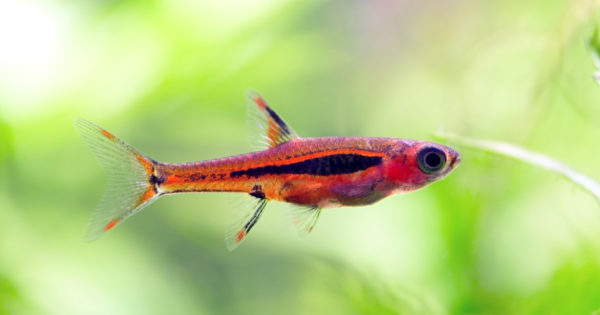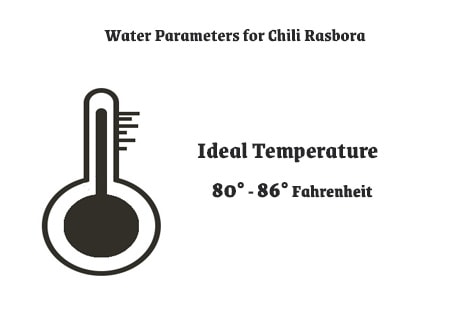Chili Rasbora is also known as mosquito rasbora. While they are referred to as rasboras, they no longer belong to the exact genus of Rasbora. In 1978, they were described as Rasbora xerophthalmia Brigitte but were later moved to the Boraras genus. This was based on morphological differences. It is also believed that they were referred to as mosquito rasbora due to the amount of blood-sucking insects that were present when they were discovered!
These charming small fishes are relatively easy to care for. However, they can be sensitive to water quality, so they’re not ideal for beginners. The fish usually occupies the top and middle level of the water column. Although, it can be seen swimming and feeding in the lower and middle water columns too. Their size, color, peaceful behavior, and schooling habits can help increase the tank’s aesthetic value.
Even though they seem to be easy to care for, a comprehensive guide will help make sure that the fish gets what it needs. With this guide, you will gain information about the fish and ways to care for them.
| Information Chart | Chili Rasbora |
| Scientific Name: | Boraras brigittae |
| Family: | Characidae |
| Care Level: | Easy |
| Temperament: | Peaceful |
| Color: | Red and Black |
| Lifespan: | 6-8 years |
| Size: | Half an inch |
| Diet: | Omnivorous/Micropredators |
| Minimum Tank Size: | 5 gallons |
| Temperature: | 80 degrees to 86 degrees Fahrenheit |
| Water Conditions: | Soft Water |
| Tank Mate Compatibility | Peaceful Community |
Table of Contents
Chili Rasbora Appearance

Chili Rasboras are tiny in size, but their vibrant color makes up for their size. A shoal of these fishes swimming together is a striking sight in the aquarium. Their rich color and their aesthetic value are the reasons why hobbyists keep them as pets.
The fish’s body is an intense red color. It has a dark stripe and small darker spots at the base of the caudal and anal fins. The edge of the dark stripe marking is highlighted with a beautiful crimson band.
The anal and dorsal fins have dark marking along with the anterior parameters. Male specimens come with beautiful red highlights. During the breeding season, male Chili Rasbora has intense red markings on their caudal and pelvic fins.
The lifespan of Chili Rasbora
The typical lifespan of Chili Rasbora is six to eight years. While their lifespan may seem long, there are a lot of things that can go wrong. Their tiny size can get them sucked into filters. Being housed with dangerous tank mates can also cut short their lifespan.
With enough care and the best water conditions, the chili rasbora can live for six to eight years.
Chili Rasbora Size
The typical chili rasbora grows up to half an inch long. Even after reaching a mature age, this fish remains to be small. This makes them a nano fish species. Their size makes them a perfect tank mate for other small species of fish or invertebrates.
Natural Habitat and Origin
The Chili Rasbora was first described by Dieter Vogt in 1978. He named the fish Rasbora Urophthalma Brigittae to honor his wife, Brigitte. The fish’s natural habitat is swarming with mosquitos. Hence, they are also known as Mosquito Rasbora.
Chili Rasbora comes from the Indonesian province of Kalimantan Tengah and Kalimantan Seltan. They also come from Southwestern Borneo. The fishes’ natural habitat consists of blackwater streams and pools, where the water flow is prolonged. The peat-stained waters are shallow in minerals and salts. The fish also enjoys plenty of hiding places and cover provided by fallen leaves, submerged by branches and roots, and aquatic vegetation. Their shelter is shaded due to the overhanging trees and shoreline plants.
Chili Rasbora Care and Tank Set-Up
Chili Rasbora Tank Size and Specifications

Optimum Tank Size for Chili Rasbora
The recommended tank size for Chili Rasbora is 5 gallons. Due to their tiny size, they can live comfortably in a 5-gallon tank. You’ll need a larger tank if they’re being kept in a larger school or if they’re being added to a community aquarium. Even though they prefer dense habitats, they also need enough room to swim around.
Tank Shape for Chili Rasbora
Their nano-size means that one doesn’t have to worry about keeping the fish in a particular shape of a tank. They just need enough room to swim around and perfect hiding spots in the tank. If these requirements are followed, then the tank shape doesn’t matter.
Filter Type
In their natural habitats, the Chili Rasbora prefer to live in pools or rivers where the water movement is slow or moderate. Hence, the mechanical filter shouldn’t generate too much current. This would make it difficult for the fish to swim against the flow.
A simple sponge filter that provides a small amount of movement at the water surface would be a perfect addition to their tank.
Substrate
A dark-colored substrate would be perfect for a tank with Chili Rasbora. This would make its intense colors pop.
The species doesn’t burrow or forage through the substrate. So, fine gravel or sand that mimics the river bottom of the Chili Rasbora’s natural habitat will be a good choice.
How many fish in a 5-gallon tank
One should make sure that the Chili Rasbora is kept in a school of at least six. Fewer than that will not make them happy. This is because they are meant to be together. One can house two Chili Rasbora per gallon. So, six fish would be acceptable for a 5-gallon tank.
Water Parameters for Chili Rasbora
Water Temperature

The ideal water temperature for Chili Rasbora is 80 degrees to 86 degrees Fahrenheit.
The reason why such a temperature is critical for them is that Borneo sits directly over the equator. This means that they live in hot and steamy temperatures throughout the year. The tank water temperature should not fall below 76-78 degrees Fahrenheit because it lowers their immunity and opens them up to various infections.
Considering their sensitivity to water temperatures, it is better to keep them in mature temperature. Along with making sure that the tank’s temperature is perfect, one must ensure that the water is not too hot for the Chili Rasbora. Their water can get heated due to exposure to direct sunlight. You can avoid this by using a plant cover.
Water Flow Rate
As mentioned above, Chili Rasbora prefers to live in water with a slow or moderate flow rate. You can control this by using a mechanical filter that doesn’t generate too much current. A quiet and moderate flow rate will help the fish stay active and swim around freely.
pH Level

The perfect water pH level for Chili Rasbora is 4.0. In their natural habitat, the species live in highly acidic water. Anything over 6.0 to 7.0 will make the tank environment extremely stressful. Dead plants like Indian Almond Leaved and driftwood release tannins into the water. This would bring down the pH level. One can also keep bottles of blackwater extract to prevent a water change. Maintaining a perfect pH level will help the fish grow more robust and live longer.
Water Hardness
In their natural habitats, Chili Rasboras live in incredibly soft waters. They are from blackwater ponds and streams where the water flows through peat moss beds and thick jungles. Such an ecosystem creates the constant disposal of leaves and twigs into the water. As a result, the water chemistry is exceptionally soft, with no measurable hardness. These soft waters contain very few minerals or salts. For a healthy fish, the water hardness should be between one to ten dKH. The regular tap water supply has chlorine and other additives in it that keep the water clean. These additives are toxic for the fish. Hence, one should use a water softener designed for aquariums.
Regular replacements of the water would help in keeping the fish healthy. You can replace 10 percent of the water every week. Twenty-five percent of the water can be changed every 15 days. You can also replace 40 percent of the water every month. Any of the three alternatives mentioned above will be beneficial.
While changing the water, its parameters but be kept in mind, a sudden change in the temperature or the pH level can be lethal for the fish. The new batch of water must have the same parameters as the old one. Also, one must never change the water content altogether as this could kill off beneficial bacteria needed for maintaining the balance in the tank’s ecosystem.
Each week one will also have to use an aquarium vacuum cleaner to remove any uneaten fish food, fish waste, and decaying plant matter from the substrate and the areas where food accumulates. Areas below the decorations, around plant bases, and beneath the box filter should be cleaned using a vacuum. Neglecting this task can spike up the ammonia produced by the decomposing organic waste has. This will make the water toxic for the fish.
Filter cartridges should also be changed periodically as per the manufacturer’s guidelines. One will also have to rinse the filter to remove the sludge that will otherwise prevent water flow.
Chili Rasbora Tank Landscape
Like other fish species, Chili Rasbora would thrive if one provided them with the perfect aquarium environment that replicates their natural habitat. Giving them enough space to swim around and be active will also be highly beneficial for the livestock. Hence, one must strategize what to put into the tank before buying the fish.
Best Plants for Chili Rasbora Tank
Live plants are essential for keeping the Chili Rasbora active and healthy. They absorb nitrate, carbon dioxide, and other toxic compounds. They release oxygen, provide shade, and make the tank look prettier.
Finding the right plants can be a task because not all plants thrive in temperatures beyond 78 degrees Fahrenheit. Plants that do well in Angelfish and Discus Tanks would be perfect for a Chili Rasbora tank.
Amazon Swords, Java Moss, and Java Fern provide the cover that the Chili Rasbora needs. These plants multiply and are excellent low-light plants.
Most floating plants would be a great addition to the tank. However, one shouldn’t cause overcrowding in the tanks to the point light stops penetrating the tank. Plants like Bacopa sp., Vallisneria, Guppy Grass, Hornwort, Salvinia, Duckweed, etc., are some of the plants that can be perfect for a Chili Rasbora tank.
Decorations for Chili Rasbora Tanks
Decorations that mimic the natural habitats of Chili Rasbora would be the best for them. One would need to include lots of lush planting that the fish can use for cover. Driftwood, twisted roots, rockwork, and caves would be a perfect addition to the tank. Banana stems and palm flowers would make a nest addition to the tank too.
It is essential to leave plenty of space in the middle water column because this is where the fish can school together.
Lighting for Chili Rasbora Tanks
The natural habitat in which Chili Rasbora lives is in dense forests and is shaded by the overhanging tree canopy and lush shoreline vegetation. You can dim the lighting in the aquarium by using floating plants to diffuse the light and provide shelter and cover for the fish. You can choose a lighting unit that allows them to alter the light that they have in their tank. Plants also act as a natural dimming agent.
Feeding Chili Rasbora
Best Diet for Chili Rasbora
Chili Rasboras are pretty straightforward when it comes to feeding. These species are essentially omnivorous. This means that they need a diet containing a mixture of vegetables, plant matter, and meaty protein. The biggest challenge would be finding small enough foods to fit into the fish’s tiny mouths.
Lives foods are an excellent option for the fish. Small daphnia, micro-worms, Baby Brine Shrimp, Wingless Fruit Flies, Mosquito Larvae, Vinegar Eels, Small Bloodworms, etc., are some of the best options. Dried fish food is a much better option to feed the Rasbora. However, they do not have any nutritional value. One must make sure that they use high-quality fish flake or pellet food. They must crumble this into powder form so that the fish can quickly eat them. One can also feed golden pearls, brine shrimp eggs, and crushed freeze-dried daphnia.
Foods under 100 to 150-micron size range are suitable for small fish. 500-microns are fine for small adult fish, 800-micron size ranges are acceptable for full-grown adult fish.
How often should you feed Chili Rasbora?
Chili Rasbora should typically be fed twice a day. Instead of offering them one large meal, it’s better to provide them with tiny amounts of food. Hence, two small meals are the best option. You can opt for an automatic fish feeder with a timer if they’re not around to feed the fish. The feeder will provide them with small portions of food two times a day. Such devices are an ideal option for busy aquarists.
Chili Rasbora Behaviour and Temperament
Are Chili Rasbora lone or societal?
The Chili Rasbora is timid and peaceful, which makes them an excellent addition to the aquarium community. They can live in a stress-free environment provided that they’re not kept with aggressive tank mates. They have exciting schooling behavior, which makes them an excellent addition to the tank. Due to its schooling behavior, the fish can be the highlight in any peaceful community aquarium.
Chili Rasbora Tank Mates
Ideal Chili Rasbora Tank Mates
Ideally, one should choose tank mates that are also small, shy, and non-aggressive. One should stick to peaceful, soft water fish smaller than two and a half inches in length.
Some good options are Neon tetras, Small Catfish, Gourami, Dwarf Cichlids, and other Rasboras. Invertebrates like dwarf shrimps and aquatic snails can be a great addition. They will also help in keeping the tank clean. Other species like Cherry Shrimp, Amano shrimp, and Mystery Snails are also ideal tankmates for this fish.
Bad Tank Mates for Chili Rasbora
Large and aggressive fish such as bettas and angelfish should be avoided. Invertebrates like Crabs and Crayfish can be dangerous for the Chili Rasbora. These creatures would gladly snack on the Rasbora because of their advantage over the tiny species. Other species to avoid would be most barbs, giant danios, larger gouramis, and other medium/large sized community fish.
Breeding Chili Rasbora
Chili Rasbora is easy to breed in the tank because they ignore their shoals and eat them as other species do. One can set up a separate breeding tank to land up with some small fry in their display aquarium.
If one has a shoal of eight to ten rasboras, spawning between the males and females will occur once the fish mature. Once the eggs are laid, they will sink to the bottom of the tank. Hatching will start within 36 to 72 hours. After 36 to 48 hours, the fry begins to swim around.
Chili Rasbora Breeding Level- EASY
Chili Rasbora Sexual Dimorphism
To distinguish between male and female Chili Rasbora, you can look at the bellies of the fish. Females are noticeably rounder-bellied, and males have intense coloration. Females are a little larger than males. Males are mote attractive with dominant traits.
Chili Rasbora Common Diseases and their Treatment
Fungal Infection
There are many types of fungal infections, but some look like bacterial infections as well. Ich X and Erythromycin can be used simultaneously to treat this.
Bacterial Infection
Bacterial infections can cause red streaks, red ulcers, fuzzy growth, popeye, and bloating. They can be external or internal. Poor water, bad food, stress, etc., can contribute to bacterial infections.
Columnaris (Cotton Mouth Disease)
Bacterial gram-negative organisms are responsible for this disease. Fungi are often confused with bacteria in this situation. There may be discolored scales, popping off, grey spots, lesions on the back, lesions around the mouth, and fuzzy patches caused by other infections.
Ich (White Spot Disease)
ich is caused by a parasite that looks like white bumps on the fish. This parasite can attach to bodies, fins, and gills. Ich-infected fish scratch themselves against objects before white spots appear.
Are Chili Rasbora right for you?
Chili rasboras are gentle and shy. They are beautiful to look at because of their vibrant colors and playful behavior. They are also good at getting along with other small creatures. They can enhance the aesthetic value of the tank. Since they are relatively easy to care for, they can be a stress-free addition to your tank.
FAQ
Chili Rasbora appreciates lush vegetation because it mimics their natural habitation in Indonesia. It gives them hiding places and nutrition from microscopic creatures found on the plants’ leaves. The lush vegetation also filters light, so the Chili Rasbora is not overexposed to heat and light.
Absolutely! The Chili Rasbora is a schooling fish. It is recommended to have more than six of them in a tank. They are designed to be together, and a single fish in the tank would be rather unhappy. Being around their own gives them a sense of security and stability.
Conclusion
Chili Rasbora is one of the most powerful creatures that can be kept as a pet. Their non-demanding nature and their peaceful behavior make them an excellent addition to the tank. As long as the tank is kept clean, you do not have to worry about its health. Keeping the tank clean also prevents them from becoming victims of a host of diseases.
Keeping all of these care guidelines in mind, the Chili Rasbora can be a great pet in your aquarium!
